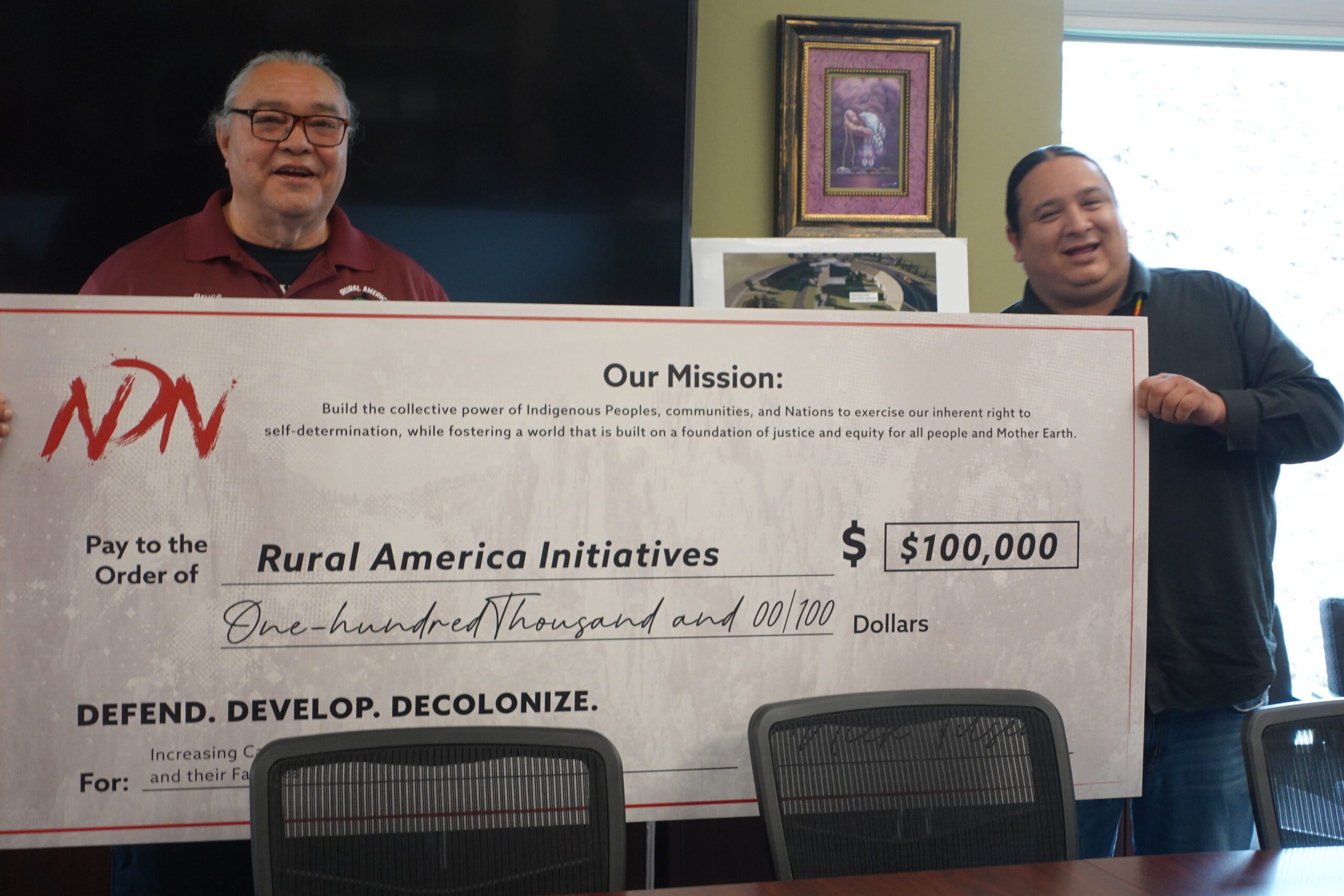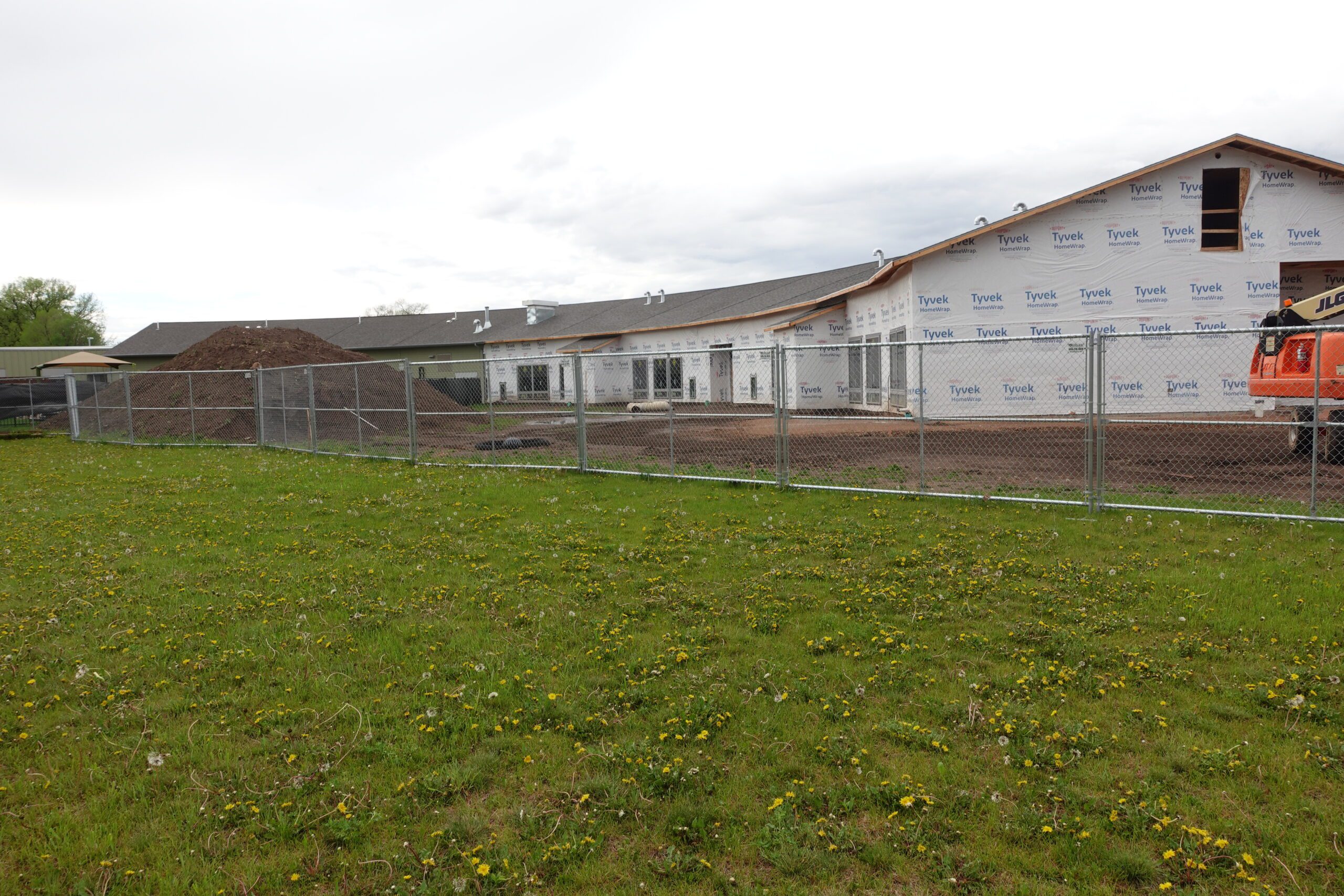NDN Collective gives back to the community

NDN Collective President and CEO Nick Tilsen presenting RAI Executive Director Bruce Long Fox with generous donation. (Photo by Marnie Cook)
RAPID CITY — NDN Collective, on a cooler than normal May afternoon, made a generous donation of $100,000 to Rural American Initiatives (RAI). RAI, which serves low-income Native families, continues to expand to serve the growing Native population in Rapid City. The small town on the edge of the Black Hills of South Dakota remains a major Indian population center in the region, just as it was before first contact. Nick Tilsen President and CEO of NDN Collective said that Rapid City has one of the largest populations of Native people’s outside of the reservations “Supporting Native groups like RAI is fundamentally important, especially when it comes to servicing the young people. It was an easy one for us,” said Tilsen referencing the donation, “If we can support the families, it stabilizes our entire community. So we are humbled to be able to give back to RAI.”
When RAI launched 37 years ago, it was one of the only organizations in the area offering assistance to children and families. The last decade, however, there has been a consortium of organizations funded by philanthropic foundations that have begun to fill the gaps of need in both rural and urban Lakota communities, to lift Native Americans and their communities out of poverty by using a different approach and bypassing the Colonial-era style that has historically restricted Native people economically.
The city’s population continues to grow said RAI’s Executive Director Bruce Long Fox. With the Native population growing at a greater rate than non-Natives, Long Fox realized that RAI would have to expand because of that growth.
After launching the capital campaign in 2022-2023 to raise money for the expansion and breaking ground on the project earlier this year, Long Fox said they are now about two-thirds of the way around. “Our existing building looks like a Thunderbird. It was originally intended to be a Medicine Wheel, but we’ll eventually get there, we’ll eventually get all the way around.”
Long Fox said what they are really doing is child care and also economic development. They are serving students in the Head Start and Early Head Start programs, “and then adding 8 classrooms, with 8 students each – there’s only 8 allowed per classroom – so that’s an additional 64 students. That’s 64 families that we can help,” said Long Fox. “If we can give them free childcare and they don’t have to worry about their kids, they know they’re safe and well taken care of, then they can go and earn a living, maybe get a place to live and buy clothes and food and stuff like that.”
Long Fox said the building addition cost $4.1 million and they have raised $2.3 million. Plus the additional donation from NDN Collective with whom RAI has been collaborating.
Long Fox said they are also working with the Collective in a Lakota language immersion program. “If you’re going to teach a language, zero to three is the age to start and then they go on to Head Start and then they go on to Oceti Sakowin, the immersion program under NDN Collective. Almost all of our students have gone there the last 2 years. We have about 40 graduates a year and they take care of them.”
Long Fox spoke of one of NDN Collective’s grant programs, the Collective Abundance Fund, which they give out to grantees to improve their homes, start a business, “but also to get some equity so they can be on an equal plane with the rest of the population.’
NDN Collective has been advocating at a national and international level to increase investments into Native American communities and organizations. “One of the big challenges, nationally,” said Tilsen,”if you took all of the institutional philanthropy in America, less than half of one-percent goes to Native people, yet Native people are close to 3-percent of the population in America. If you look at who is living the most in poverty, where is the lowest economic mobility in the country, where is education struggling the most, its Indigenous communities.”
Tilsen said that there is a huge discrepancy with institutional philanthropy which is mostly based in New York City, the East Coast and West Coast. “They kind of fly over the middle of America. So, we established grant-making at NDN as a strategy to get money from those places into organizations like RAI, like Wanblee ska, like He Sapa Otipi – all of these local organizations that are meeting the people’s needs.”
In the six years since NDN Collective’s inception, they have expanded their footprint around the globe. Tilsen said they use these same strategies in not only the U.S. but Canada, American territories of Guam, American Samoa, Puerto Rico – our footprint is Turtle Island. So, we have to create strategies otherwise the resources won’t come into the communities.” Tilsen said NDN Collective’s role is to be the bridge helping to increase philanthropic investment to Native communities. “We support both urban and rural Native communities, on the reservation, off the reservation, wherever Indian people are. We are everywhere. So, we fund where our people go.”
Long Fox thanked the staff at RAI for their hard work and dedication. ‘What takes a program to be successful is to have staff to hang in there with you and to believe in the mission and maybe work for a little less than other places in the community and sometimes even the reservation. It is a team and an extended team.”
Both Long Fox and Tilsen acknowledged the collaborative nature, the fight for Indigenous rights and their efforts to change the conditions for Native Americans. “Always, in every act that we have done,” said Tilsen “has been for the next generation, for the children, so they don’t have to live through racism or be impacted by it. So, this is an approach in a way for us to give back and be good relatives and members of this community.”
(Contact Marnie Cook at staffwriter@nativesunnews.today)
The post NDN Collective gives back to the community first appeared on Native Sun News Today.

